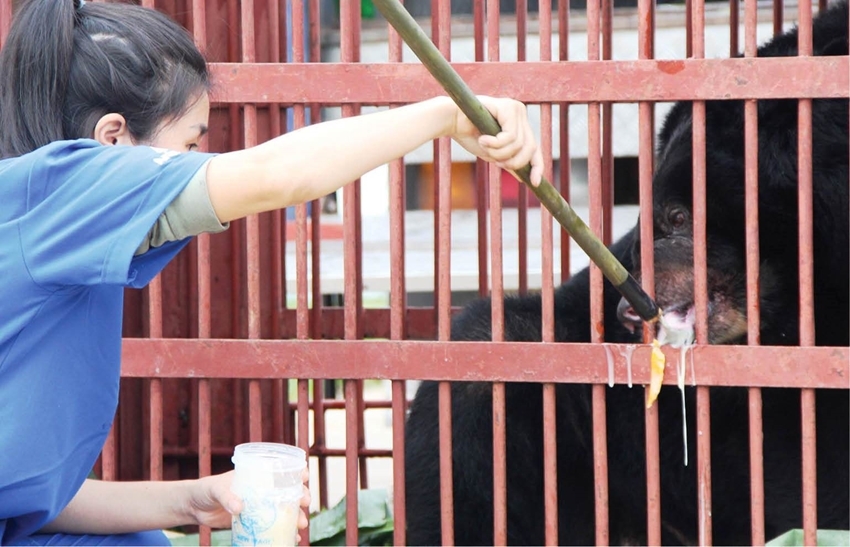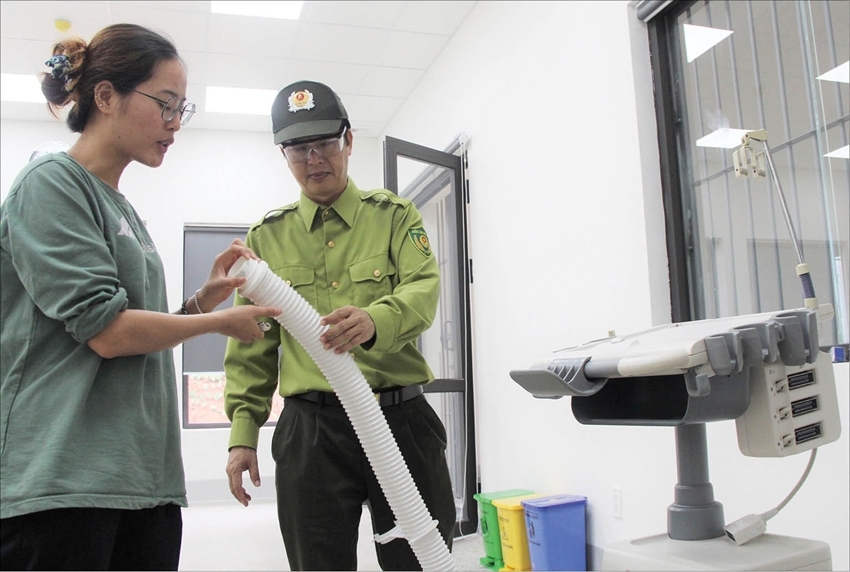"This place not only has a suitable climate for bears, but it is also an imposing destination," one person exclaimed while waiting for two bears to return to the park.
 |
| One of the first two bears brought to Vietnam Bear Rescue Center II at Bach Ma National Park |
Late in the afternoon, two bears are transported to Vietnam Bear Rescue Center II at Bach Ma National Park, but from early morning, many people await to welcome this significant moment.
Bears return
After we go past the park gate, cross the first slope about 700m long, and turn left, the space of the Vietnam Bear Rescue Center II under completion comes into sight. Going deeper, everybody is overwhelmed by a bear rescue center methodically built by international standards on a land area of more than 12 hectares.
While leading everyone to see and explain, Mr. Nguyen Vu Linh, Director of Bach Ma National Park cannot help taking pride when the park was chosen as the place to build a "bear farm".
"Besides the suitable climate, the park also basically meets the standards set by the experts," Mr. Linh said.
Constructed in 2022, Vietnam Bear Rescue Center II has finalized phase 1 with many closed items, ensuring technique and habitat for bears. Aside from the bear houses, there is also a wild boarding area, an administrative building, an employee resort, a quarantine area, veterinary hospital, and a food-processing area for bears... Surrounding this area is a vast tract of forest. Entering this area is like getting lost in a wild natural world.
 |
| Bear Hospital with many modern care facilities |
“Rescued bears brought to the center will be quarantined and monitored. After the quarantine period, the bear will be examined to determine its health status. Depending on the situation, there will be care measures for each individual", veterinarian Tran Khanh Ngan, an officer working at Vietnam Bear Rescue Center II said.
Ngan also takes everyone around, introducing the closed process of the bear hospital. The hospital interior is divided into many rooms with countless modern facilities such as ultrasound machines, on-site blood testing equipment, anesthesia machines...
“Depending on each individual's illness, doctors will write prescriptions. There were cases where bears had the lens replacement and gallbladders removal...", a female veterinarian with several years of work experience at Vietnam Bear Rescue Center I in Tam Dao National Park (Vinh Phuc) before working at Center II in Bach Ma, said.
Not far from the bear hospital is a solidly built bear house, connected to an outdoor semi-wild space surrounded by a two-layer fence system. The semi-wild area is just like a park. Here, bears will be free to play and climb. This area includes many trees, grass, a lake system, and obstacles for bears to freely move around. This space will diversify the habitat for bears, helping them quickly recover their natural abilities and flexibility.
"To ensure safety, every area is designed with a two-layer fence system, including a layer with electric shock. Once a bear touches it, the electric shock fence will automatically push it out," Mr. Nguyen Vu Linh, Director of Bach Ma National Park points towards the fence and introduces it to visitors.
For bears to have a better life
The car carrying two bears rescued in Hanoi moves to Vietnam Bear Rescue Center II in Bach Ma National Park after more than a day of traveling more than 800km. The movement process is considered slow because every 2-3 hours, the car has to stop for experts to do a health check and give water and food to the bears.
The car door is slowly opened by the experts; hundreds of eyes are watching. The two bears are placed in two cages; their eyes are bright as they are brought to their new home. The group of experts directly follows the two bears, and the on-site group of experts discusses information about the age, health, and characteristics of each bear... The veterinarian immediately provides milk and honey for each before the cage is moved out of the truck by using an automatic lifting control system.
While both bears seem amazed to have a new life, the observers look delighted because the bear rescue journey from now on will open up many new prospects, and the number of rescued bears will be larger.
"As soon as the bears get off the bus, they are taken to the quarantine area. Depending on the situation, they are quarantined for 30-45 days and closely monitored," veterinarian Tran Khanh Ngan explained said the two bears are named Armstrong (male bear) and Buzz (female bear) - the names of the first two astronauts to set foot on the moon. Once brought into the quarantine area, the bears will be lured into another spacious cage and only those with duties will be allowed to enter and exit this area.
Aside from these two bears, Vietnam Bear Rescue Center II in Bach Ma National Park will be officially put into operation, expected to have a scale of raising more than 300 bears. Mr. Nguyen Vu Linh hopes that the establishment of this center will soon put an end to the practice of bear bile farming and, more importantly, that the bears in captivity will be transferred here and live a better life.
“Bach Ma National Park will have more addresses to visit, more models to study, and raise awareness for tourists and local communities of the responsibility and participation in protecting wild animals in general and bears in particular," Mr. Linh confided.
